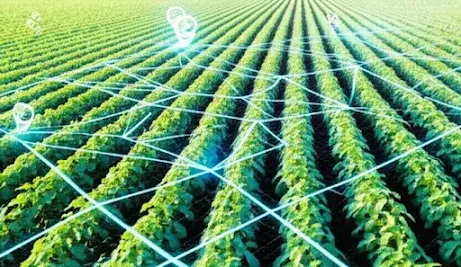Agricultural Technology: Revolutionizing Farming for a Sustainable Future
In recent years, agricultural technology—often called AgriTech—has become a driving force behind the modernization and sustainability of global farming practices. As the world's population continues to grow and climate change presents new challenges, integrating technology into agriculture is not just a luxury but a necessity. From drones and IoT sensors to AI-driven analytics and smart irrigation, agricultural technology is reshaping the future of farming.
In this blog post, we will explore agricultural technology, its major applications, benefits, real-world examples, and how it is paving the way for sustainable agriculture.
In this blog post, we will explore agricultural technology, its major applications, benefits, real-world examples, and how it is paving the way for sustainable agriculture.
What is Agricultural Technology?
Agricultural technology (AgTech) refers to using scientific techniques, innovations, and advanced tools to improve the efficiency, productivity, and sustainability of agricultural processes. This includes a wide range of applications such as:
- Precision farming
- Automated machinery
- Remote sensing
- Smart irrigation systems
- Soil and crop health monitoring
- Genetic engineering
- Supply chain optimization
- Agricultural technology combines traditional farming knowledge with cutting-edge tools like AI, robotics, GPS, big data, and biotechnology.
Why Agricultural Technology is Important in 2025 and Beyond
The global agricultural sector faces numerous challenges:
Feeding a growing population: The world is expected to reach 9.7 billion people by 2050.
Climate change: Unpredictable weather patterns, droughts, and floods are affecting crop yields.
Labor shortages: Many countries are experiencing a shortage of farm workers.
Sustainability concerns: There is an urgent need to reduce water usage, chemical inputs, and greenhouse gas emissions.
Agricultural technology addresses these issues by offering data-driven solutions that improve yields, reduce waste, and promote environmental stewardship.
Top Agricultural Technologies Transforming the Industry
1. Precision Farming
Precision agriculture involves the use of GPS, GIS (Geographic Information Systems), and remote sensors to monitor and manage field variability. Farmers can determine the exact amount of water, fertilizer, and pesticides needed in different parts of the field, optimizing inputs and maximizing yields.
Benefits:
- Reduced resource usage
- Higher productivity
- Improved soil health
2. Drones and Aerial Imaging
Drones are being widely used to capture high-resolution aerial images of farmlands. These images help in identifying crop diseases, nutrient deficiencies, and pest infestations early.
Use Cases:
- Crop mapping
- Livestock monitoring
- Irrigation assessment
3. Smart Irrigation Systems
Water scarcity is a global issue. Smart irrigation technologies use IoT sensors to monitor soil moisture and weather conditions, delivering water only when and where it's needed.
Advantages:
- Reduced water consumption
- Lower costs
- Healthier plants
4. Robotics and Automation
Agricultural robots (AgRobots) perform labor-intensive tasks such as planting, weeding, harvesting, and spraying.
Examples:
- Robotic harvesters
- Automated tractors
- Weed-removing robots
These machines increase efficiency and reduce dependence on manual labor.
5. AI and Big Data in Agriculture
Artificial Intelligence is transforming farming by providing predictive insights through real-time data analysis. AI models help forecast weather patterns, predict crop yields, and detect diseases before they spread.
Tools:
Benefits of Agricultural Technology
1. Increased Efficiency and Productivity
By using advanced tools, farmers can monitor crop health, soil conditions, and equipment performance with precision. This leads to increased productivity per acre and better resource management
2. Cost Reduction
Automated systems help farmers cut down on labor, fuel, fertilizer, and water costs. For instance, a smart irrigation system can save up to 50% of water and reduce electricity bills.
3. Environmental Sustainability
Modern agricultural practices minimize environmental impact by:
- Reducing chemical use
- Lowering carbon emissions
- Promoting soil health
This aligns with the growing demand for eco-friendly farming methods.
4. Real-Time Decision Making
Technology allows farmers to make informed decisions quickly. With mobile apps and cloud platforms, data can be accessed and acted upon in real time.
Real-World Examples of AgTech in Action
India
Startups like DeHaan and CropIn are helping small farmers by providing end-to-end agricultural solutions, ranging from crop advice to supply chain management.
United States
John Deere has developed autonomous tractors equipped with AI, GPS, and computer vision to optimize plowing and seeding with minimal human intervention.
Africa
AgriTech solutions like Twiga Foods and Apollo Agriculture are empowering African farmers with digital credit, input supplies, and market access through mobile platforms.
Challenges Facing Agricultural Technology
While AgTech is promising, there are some hurdles:
High initial costs: Advanced tools can be expensive for small-scale farmers.
Digital divide: Lack of internet access in rural areas hinders technology adoption.
Training and education: Farmers need guidance and training to use new tools effectively.
Data privacy concerns: As with any digital system, protecting farm data is essential.
Addressing these challenges through government support, public-private partnerships, and inclusive education programs is key to widespread adoption.
The Future of Agriculture: What's Next?
The future of agriculture lies in smart, connected, and autonomous farming. Here's what we can expect:
5 G-powered remote farms with real-time monitoring
Blockchain for transparent food traceability
Vertical farming and hydroponics for urban agriculture
Climate-resilient crops developed through gene editing
Agri-fintech platforms to provide farmers with access to digital finance
As technology becomes more accessible and affordable, even small-scale farmers will be able to benefit from the digital agricultural revolution.
Conclusion
Agricultural technology is not just transforming how we grow food—it's shaping a sustainable future for our planet. With innovations in precision farming, AI, robotics, and smart irrigation, farmers can produce more with less. While there are challenges to overcome, the opportunities are vast and promising.
In 2025 and beyond, AgTech will play a vital role in feeding the world, combating climate change, and improving the livelihoods of farmers. Whether you're a farmer, entrepreneur, investor, or policymaker, now is the time to embrace and support agricultural technology.





